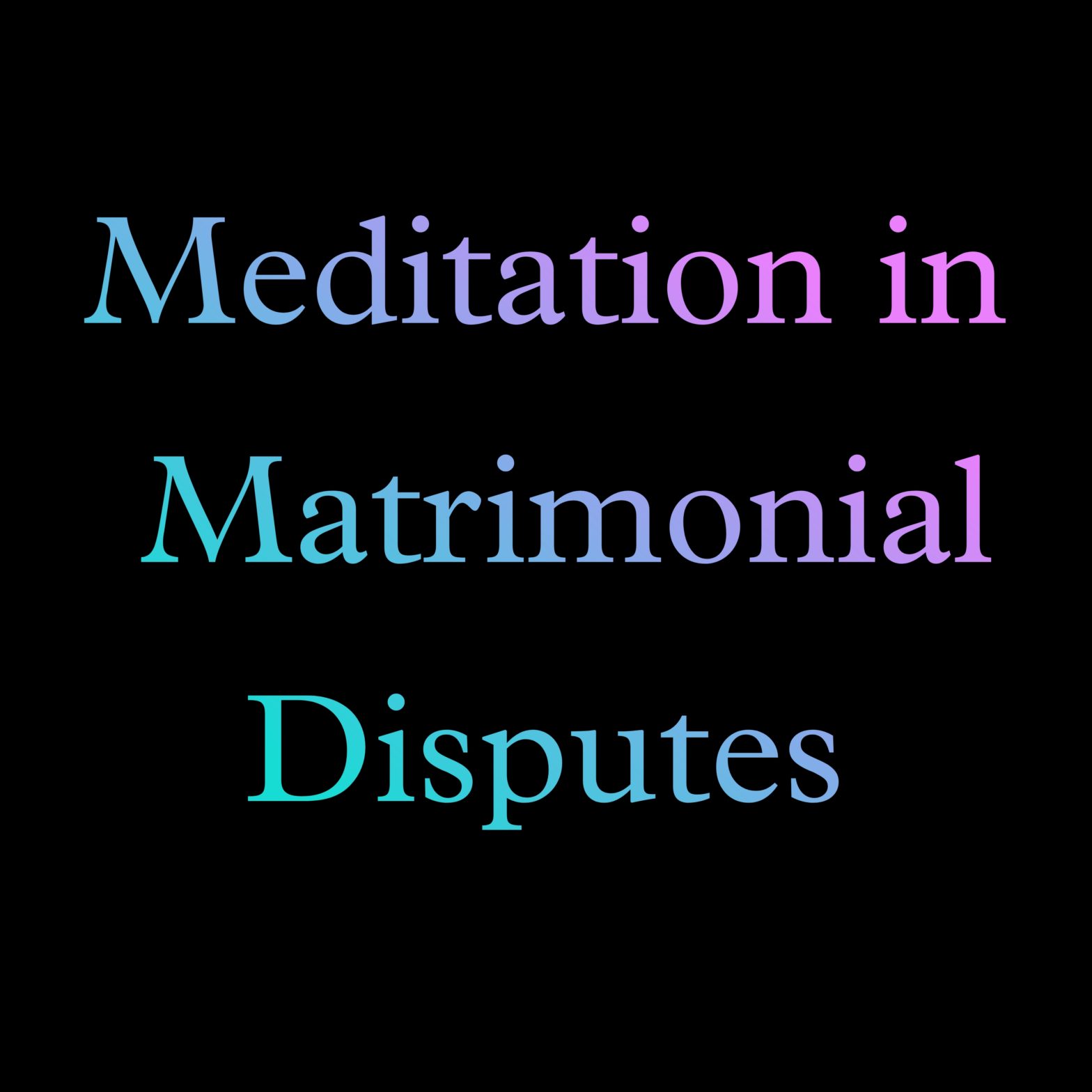This article tells us about the role mediation plays in family law disputes. The article also explains why the court suggests people first go for mediation in family law disputes. Further, we will discuss some important cases and then conclude the article.
Introduction
Marriage is a socially supported union between individuals in what is intended to be a stable, enduring relationship. It is the basis for the family and the institution, defined by six social functions: regulation of sexual behavior, reproduction, nurturance and protection of children, socialization, production, consumption, and the passing on of ascribed statuses such as race. Marriage and the family rest on many beliefs, the most important of which is kinship. Marriage is not only a social event but also a legal commitment. The foundation of a sound marriage is tolerance, adjustment, and respecting one another. Tolerance to each other’s fault to a certain bearable extent has to be inherent in every marriage.
Life comprises several differences between and among people, groups and nations. There are cultural differences, personality differences, differences of opinion, situational differences. Unresolved differences lead to disagreements. Disagreements cause problems. Disagreements unresolved become a dispute. Unresolved disputes become conflicts. The dispute which arises between a couple of the institution of the marriage is known as a matrimonial dispute. A dispute may develop into a conflict.
Marriages on crutches need aid and attention. They limp and need intensive care treatment6. Family or matrimonial issues were considered too sensitive an area to be left to the mercy or adversarial jurisprudence of the present legal system which by its very nature involves a lot of mudslinging on either side. Litigation in respect of family disputes requires a special approach.
Mediation is the process where a third party interferes in a dispute between two parties. It is an attempt by a third party, referred to as a mediator. The mediator must be unbiased and neutral toward both sides. Mediators do not render a decision, but rather facilitate the resolution of disagreements or conflicts between the parties. Open communication is maintained between the parties during mediation so that both can clear their doubts and misconceptions and, with the assistance and ideas of the mediator, reach a consensual decision. Many people choose to go to the mediation facility first before going to court. Anyone can request mediation by submitting a written request ahead of time. When it comes to family law conflicts, mediation has proven to be a viable choice.
History And Origin

The use of mediation, as an Alternative Dispute Redressal (ADR) mechanism, dates back to centuries before the British came to India. Back then informal panchayats were used to resolve disputes between the parties where the respected elderlies of the villages or the Mahajans were appointed as mediators. To date, Pinchas or Pancha Parmeshwars, as neutral third parties, are used to settle disputes informally between the erring individuals or groups, by some tribes in India. However, with the onset of British colonialism, mediation began to be recognized as a formal and legalized ADR mechanism.
Mediation gained popularity as an ADR mechanism with the re-introduction of Lok Adalats in the Indian Judicial system. Enacted in1987, the Legal Services Authority Act gave statutory status to the Lok Adalts in India for the first time. Under this act, the decision of the Lok Adalats has been awarded the same status as that of a civil court.
The development of mediation as an ADR mechanism can also be attributed to section 89 of the Civil Procedure Code (CPC), 1908 which was inserted by the CPC (Amendment) Act, 1999 with prospective effect from 1/7/2002. This particular development was due to the efforts of Hon’ble Mr. Justice A M Ahmadi. Ahmadi, the then Chief Justice of India, had invited the Institute for the Study and Development of Legal System (ISDLS) to India for a national legal exchange program between India and the USA.
Types of Mediation
- Court Referred Mediation– Under Section 89 of the Code of Civil Procedure, 1908, the court may send a pending case for mediation in India. This sort of mediation is common in matrimonial issues, especially divorce cases.
- Private Mediation– Qualified personnel works as mediators on a fixed-fee basis in Private Mediation. Anyone can choose mediators to resolve their issue through mediation, including courts, the general public, corporations, and the government sector.
Process of Mediation
- Preparation– Before the mediation process begins; the mediator can meet with the parties and give them instructions on how to go through the processes. He also clarifies any ambiguities and answers any inquiries that may arise. This talk does not have to be held face-to-face; it can be conducted over the phone.
- Introduction– First and foremost, the mediator will make opening remarks in which he will explain his duty as a mediator. The mediator will inquire whether both parties are in agreement with the process. If both parties agree, the procedures of the mediation process are followed. If the parties decline to refer the case to mediation, the Court may impose cost fines as a result of their failure to follow the procedure.
- Statement of Problem– As part of their opening statement, the mediator allows the parties to explain their difficulties. Because of this, both the parties and the mediator should have a greater grasp of the issue by the end of these comments.
- Joint Discussion– The mediator will review the concern of both parties and will ask pertinent questions to gather additional information. He’ll also be able to figure out which concerns should be resolved first as a result of this debate.
- Private Discussion– Following the combined discussion of the issues, each party is given the option to speak privately with the mediator and, if desired, with their lawyers about their concerns. It is a crucial stage that assists the parties in preparing for negotiations.
- Negotiation– The parties will continue to negotiate until they reach an agreement that is agreeable to both parties. The mediator finds a solution that protects the interests of both parties. If the negotiations fail, the case is taken to court.
- Agreement– The parties are re-assembled once the terms of the agreement have been agreed upon. The terms of the settlement would be confirmed orally by the mediator, then written down and signed by the parties. The agreement is enforceable in a court of law and has a binding effect. In a closing speech, the mediator expresses gratitude to both parties for their involvement and cooperation throughout the process.
Kinds of disputes arising in a family
There are various kinds of disputes which happen in a family and such disputes are different for every family, ranging from a big joint family to a small nuclear family. The various disputes which occur can be listed as follows:
- Divorce and separation issues
- Inheritance
- Parenting
- Extended family concerns
- Eldercare
Mediation related to family disputes
In our society, in the earlier times, the trend was to settle the disputes among family members by sitting together and discussing them. At the village level, the disputes were many times also referred to the panchayats where the decision was taken after hearing both sides. The mediation process also plays the same role where members of a family who are in a disagreement can try to solve their grievances by discussing them instead of going to court. In family relations, peace and harmony between the members of the family are of paramount importance.
The family mediator tries to help the people reach a settlement to which both the parties agree, by encouraging communication. The family law system encourages mediation which can be done in various ways like using a family member or friend to help, informal general meeting or using a special mediation process covered under Australian Legislation The Family Law Act, 1975 known as Family Dispute Resolution in which a practitioner helps people resolve their dispute and he is not related directly to any of the parties.
There are references of mediation/conciliation in family dispute resolution which are present in the Family Courts Act, 1984, Civil Procedure Code, Hindu Marriage Act, and the Legal Services Authorities Act, 1987 that gives a special status to Lok Adalats as it has been very effective in mediating family disputes.
Mediation in Domestic Violence Cases

One has to understand the fact that domestic violence is a serious crime and should not be taken lightly. Domestic violence being a crime, someone who has committed the crime can easily escape from the same with the simple help of mediation.
Domestic Violence is a non-compoundable offense under Section 320 of the CrPC. The Supreme Court in 2013 by sanction gave the power to the courts to refer the cases mentioned under Section 498-A of IPC for mediation. For example-
In the case of Mohd. Mushtaq v. State[1], the wife had filed a case of divorce against the husband along with an FIR under Sec. 498-A of IPC, when disputes arose between them after the birth of a girl child. The Karnataka High Court referred the matter for mediation and everything was resolved amicably. The wife decided to quash the FIR she had filed and the court allowed it in the exercise of its inherent powers to meet the ends of justice.
There are certain disadvantages attached to having mediation in domestic violence cases. Like-
- The wrongdoer easily escapes without receiving the punishment and is set free to walk in society without truly being punished for his actions.
- If a crime is committed the person who does so should be punished so that it acts as a deterrence for others and helps in decreasing the rate of crime in society.
Landmark Cases

Srinivas Rao v. D.A. Deepa[2]
In this case, the Supreme Court ruled that mediation is required before a divorce can be finalized. When a case arises under Section 489A of the IPC, the Supreme Court instructs the criminal courts not to deal with the complaint unless it is referred to the mediation centers. However, in a few cases where the cruelty is particularly severe and dangerous, the criminal courts may take the case without referring it to the mediation centers. Furthermore, it has been decided that all mediation centers shall establish their litigation clinics to address marriage problems without having to go to court.
S Krishna Murthy vs. B.S Nagaraj and Ors[3]
In this case, Justice Markanday Katju held that lawyers should advise their clients for mediation, especially where the dispute is family in nature. Otherwise, the litigation goes on for years and decades which is detrimental to both parties.
V. Rao vs. L.H.V. Prasad[4]
In this case, the court held that marriage is a child-centric heterosexual institution in our society. However, if marriage as a unit breaks down, the adjustments of various relations are required rupturing the usual structure and peace of the family. So, the family laws and courts mostly encourage matrimonial disputes for reconciliation and settlement by amicable agreement instead of litigation.
Salem Bar Association v. Union of India[5]
In this matter, Writ Petitions were filed challenging the Amendments made to the Code of Civil Procedure by way of Amendment 46 of 1999 and Amendment 22 of 2002. Amongst other amendments, the attention of the Hon’ble Supreme Court was drawn to Section 89 of the Code of Civil Procedure.
The Hon’ble Supreme Court observed that the provision of Section 89 of the Code of Civil Procedure has been inserted to ensure that all the cases which are filed in the courts need not necessarily be decided by the courts. The Hon’ble Supreme Court opined the need to promote Alternate Dispute Resolution. It, therefore, considered Section 89 to be a welcome step. It was therefore suggested by the Hon’ble Supreme Court, that a Committee be constituted so as to ensure that the amendments made to the Code of Civil Procedure become effective and result in the quicker dispensation of justice.
Current Scenario
Mediation has emerged as the most widely accepted dispute resolution mechanism for settling matrimonial disputes. The problem arises when these include cases of domestic violence. While using mediation to resolve disputes of such nature, there are two opposing ideologies that exist in society. The advocates of mediation hold mediation to be a favourable mechanism as it safeguards family relationships; more specifically children from having to experience the severities of the traumatic process ordinarily attached to a typical divorce and also provide speedy justice. Whereas the critics of mediation hold mediation to be ineffective as the wrongdoer escapes without being punished through the State’s orderly penal apparatus.
There are several advantages attached to the mediation of matrimonial affairs such as confidentiality, cost-effectiveness, informal procedures, power of control, full freedom of parties to reject the outcome, mutuality, etc. The most attractive and indispensable feature is that it follows the principle of timely justice.
Comparative Studies
In Germany, mediation has only been regulated by statute. In court, mediation and conciliation have been experimented, since it was first introduced in the Landgericht Gottingen in 2002.
In Australia too, mediation has proved to be a popular method for dispute resolution in family cases. The Family Court of Australia since its establishment in 1976, has provided family counselling services. The contribution of counselling professionals has been appreciated by the judiciary and policymakers.
America has introduced online divorce mediation which is through modern video conferencing which reduces the travel and hearing room costs.
In Italy, the development of family mediation has been very limited despite having some proposals for legislation and local authorities to promote mediation. In some pieces of legislation currently in force, there is even some confusion between family mediation, counseling, and other social services aimed at giving support to families.
Conclusion
Therefore it’s concluded that different dispute resolution mechanism is a lot more advantageous than the court redressal mechanism if enforced with a robust body established, virtuoso mediators and trained judges, with effective case management, Hence, it may be precisely concluded that in step with analysis the choice dispute resolution mechanism is seen to be a lot of advantageous than court redressal mechanism since, it’s more cost-effective and fewer time-intense that in consequence, it can scale back the pendency of cases within the courts and offers a lot of satisfying and acceptable solutions to the parties in disputes because it is settled with active participation and convenience of the parties.
The variety of cases resolved through the ADR mechanism are rising because of the legislative recognition given to ADR in section 89 of the code of civil procedure, ADR mechanism is conducted seriously and cautiously. Since there’s a rise in the resolution of cases through the ADR method, it’s welcome by the majority of judges, lawyers and litigants. However, it’ll take an affordable time to be stock-still within the existing adversarial system because the folks square measure a lot of liable to the previous system. Although, with correct co-operation and coordination between stakeholders of the bar on a daily basis there’ll be a well-settled system for implementation of different dispute resolution mechanisms. An epitome for correct implementation of ADR mechanism Central and authorities, legislators similarly as the judiciary has got to take concrete steps which are able to widen the scope for access to justice to all or any.
FAQs
What is mediation?
Mediation is a settlement process in which either parties or Courts appoint a mediator who helps both parties on reaching an amicable solution or agreement.
What happens in mediation in a divorce case?
In a divorce case, mediators do not give judgment but allow resolution of the disagreement or disputes between the parties. Under mediation, open communication is held between the parties so that both of them can clear their doubts and misunderstandings.
What usually happens in mediation?
In mediation, the mediator helps the parties to reach a compromise. The mediator points out the issues in the case or the area of weaknesses and benefits of settling.
Who pays the mediation costs?
Usually, each party pays an equal proportion of the costs associated with the mediation, although other arrangements can be agreed upon by the parties or ordered by the court. The order of referral to the mediation usually includes an order for how the costs are to be apportioned.
What are the advantages of family mediation?
In family mediation, the matters are handled amicably without affecting the relationship between people. It provides speedy justice which also reduces the burden of the courts. It is also flexible and gives the right to the parties to decide whether they want to accept or reject the outcome of the trial.
[1] (2015) 3 AIR Kant R 363.
[2] AIR 2013 SC 2176.
[3] S.L.P. Civil) No(s).2896 OF 2010.
[4] Special Leave Petition (Crl.) No. 3164 of 1999.
[5] (2003) 1 SCC 49.

Needs amicable settlement of matrimonial cases